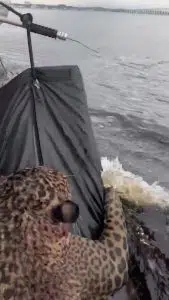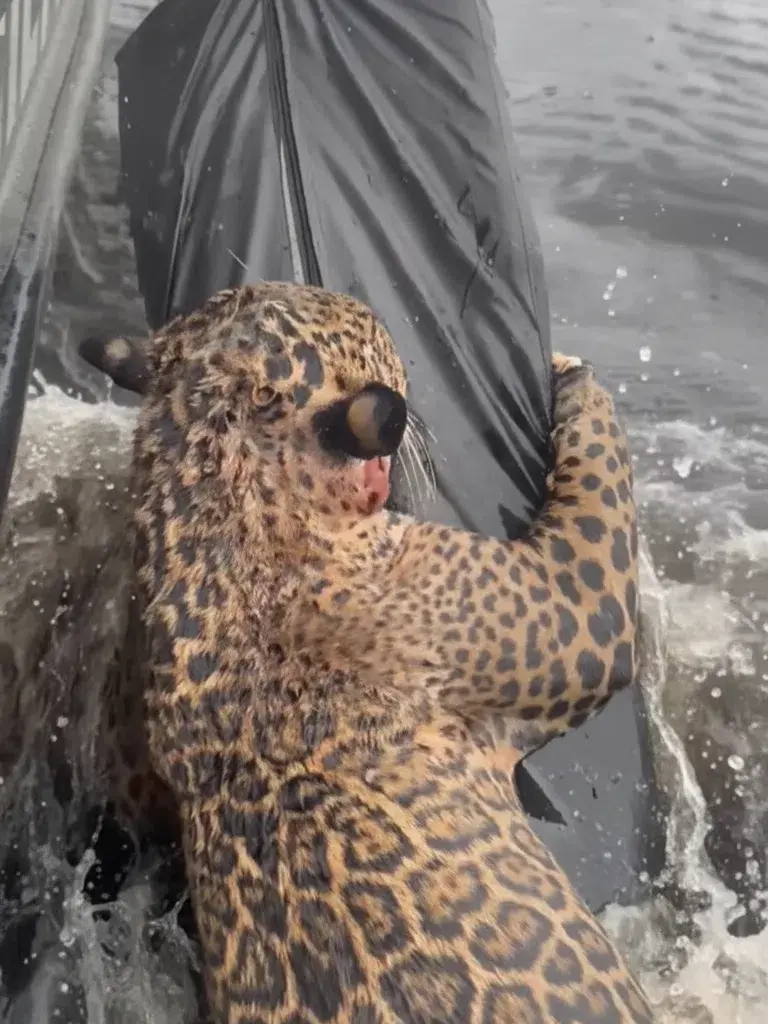Environmental agents from Manaus, Brazil, starred in a dramatic rescue after finding an exhausted jaguar in the Negro River, where it was on the verge of drowning. The visibly weakened feline was assisted with a buoy and a hook to reach the shore, in a scene that went viral on social media.
Once safe, the animal was transferred to a veterinary clinic, where specialists made a startling discovery: it had around 30 shotgun pellets in its body, mainly in the head. The wounds indicated that it had been a victim of hunters, which would explain its state of disorientation and exhaustion.
The jaguar, also known as the Panthera onca, is the largest feline in the Americas and an essential link in the ecological chain, as it regulates herbivore populations and maintains ecosystem balance.
What is the status of the injured jaguar?
According to veterinarians, the animal arrived with multiple gunshot wounds, fractured teeth, and projectiles lodged in the body, so the veterinary team began an intensive treatment to stabilize it, clean the wounds, and restore its mobility.
The animal is alive and in recovery in the city of Manaus. After surgery, it was confirmed to be a 5-year-old male with 30 pellets in its head.
Although its recovery is progressing well, its reintroduction into the wild will depend on its ability to survive without human assistance. This case once again brought to the forefront the impact of poaching on one of the most iconic species of South American fauna.
A key species at risk of extinction
The jaguar inhabits from Mexico to northern Argentina, but its population has drastically declined in recent decades. Habitat loss due to deforestation, conflicts with ranchers, and illegal hunting have led to its classification as “Near Threatened” globally by the International Union for Conservation of Nature (IUCN), and “Critically Endangered” in countries like Argentina and Brazil.
Currently, it is estimated that only about 200 individuals remain in Argentine territory, mainly concentrated in the jungles of Misiones and the north of the country. In Brazil, conservation efforts focus on the Amazon and the Pantanal, where reforestation and biological corridors projects seek to reverse habitat fragmentation.
Wildlife monitoring and rescue programs, like the one that saved this specimen in Manaus, are essential to preserve the species. Each recovered individual represents an opportunity to strengthen natural populations and maintain genetic diversity.
 The injured jaguar rescued in Brazil from a shotgun attack. Photo: Screenshot from video- X/@CerfiaFR.
The injured jaguar rescued in Brazil from a shotgun attack. Photo: Screenshot from video- X/@CerfiaFR.
Laws, Penalties, and the Fight Against Poaching
Environmental legislation in Latin America includes harsh penalties for those who capture, kill, or trade protected species like the jaguar. In Brazil, the Environmental Crimes Law (No. 9,605/1998) establishes penalties of up to five years in prison and high fines for those responsible for illegal hunting or mistreatment of wildlife.
In Argentina, the species is protected by National Law No. 22,421 for Wildlife Conservation, which considers it a criminal offense to hunt or capture animals in danger of extinction. Penalties can reach four years in prison and fines exceeding five million pesos, in addition to the obligation to repair the environmental damage caused.
These regulations reflect the growing commitment of countries in the region to protect their biodiversity. However, specialists warn that the effective enforcement of laws remains a challenge, especially in rural and forested areas where oversight is limited.

